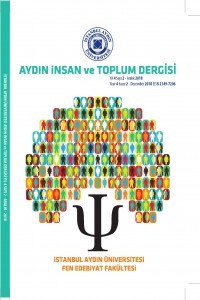Haset, İmrenme ve Kıskançlık Duygu Durumlarının Ayrııştırılması
Duyguların temel alındığı bu araştırmada kıskançlık, haset ve imrenme duyguları incelenmeye çalışılacaktır. Toplum tarafından bu duyguların ortaya konmasında ve kullanılmasında çeşitli farklılıklarla karşılaşılmaktadır. Aynı zamanda bu duyguların bireyler tarafından sıklıkla yanlış ifade edildiği ve karıştırıldığı da göz önünde bulundurulmalıdır. Yapılan çalışmada temelde, bahsedilen bu varsayımları bilimsel verilerle ortaya koymak ve bu kavram karmaşasının önüne geçmek adına yapılmıştır
Anahtar Kelimeler:
Haset, Kıskançlık, İmrenme, Duygu, His
Decomposition of Grudge, Envy And Jealousy Situations
One of the basic elements that leads human life is ‘Feelings’. Feelings are determinant in human life, therefore human beings are able to move through many virtual functions by feelings. It is extremely important to understand and explain correctly such a vital structure. This research will try to examine the feelings of grudge, jealousy and envy in terms of using feelings as base. What those feelings really mean, how they are interpreted, what types of effects they really have in terms of emotions will be revealed
___
- [1] Brehm, S.S. (1992). Intimate relationships. NY:McGraw Hill.
- [2] Bringle, R. G. & Buunk, B. (1985). Jealousy and social behavior, Review of Personality and Social Psychology, 6, 241-264.
- [3] Buunk, B. P., Angleitner, A., Oubaid, V., & Buss, D. M. (1996). Sex differences in jealousy in evolutionary and cultural perspective: Tests from the Netherlands, Germany, and the United States. Psychological Science, 7(6), 359-379.
- [4] DeSteno, D. A., &Salovey, P. (1996). Jealousy and the characteristics of one’s rival: A self-evaluation maintenance perspective. Personality & Social Psychology Bulletin, 22, 920-932.
- [5] Greenberg, J., & Pyszczynski, T. (1985). Proneness to romantic jealousy and responses to jealousy in others. Journal of Personality, 53(3), 468-479.
- [6] Izard, C. E. (1993) Four systems for emotion activation: Cognitive and noncognitive procesess. Psychological Review, 100, 68-90.
- [7] Lazarus, R. S., Kanner, A. D., & Folkman, S. (1980). Emotions: A cognitive phenomenological analysis. R. Plutchick & H. Kellerman (der.), Emotion: Theory, research, and experience (Vol. 1, s. 189-217). NY: Academic Press.
- [8] Mathes, E. W., & Severa, N. (1981). Jealousy, romantic love, and liking: Theoretical considerations and preliminary scale development. Psychological Reports, 49, 23-31.
- [9] Ninivaggi, F. J. (2010). Envy theory. Perspectives on the Psychology of Envy. Lanham, MD: Roman & Littlefield.
- [10] Pines, A. M. and Friedman, A. (1998). Gender differences in romantic jealousy. The Journal of Social Psychology, 138, 54-71
- [11] Pines, A. M., & Bowes, C. F. (1992). Romantic jealousy. Psychology Today, 25 (2), 48-56.
- [12] Smith, R. H. ve Kim, S. H. (2007). Comprehending envy. Psychological Bulletin,133(1), 46-64.
- [13] Türk Dil Kurumu, Güncel Türkçe Sözlük http://www.tdk.gov.tr/index.php?
- [14] Vaillant GE. (1976) Natural History of Male Physiological Health; The Relation of Choice of Ego Mechanisms of Denense to Adult Adjustment. Archives of General Psychiatry, 33(5), 535-545.
- [15] Van de Ven, N., Zeelenberg, M. ve Pieters, R. (2011). Why envy outperforms admiration. Personality and Social Psychology Bulletin, 37 (6), 784-795.
- [16] White, G. L. (1981a). Relative involvement, inadequacy, and jealousy: A test of a causal model. Alternative Lifestyles, 4, 291-309.
- ISSN: 2149-7206
- Yayın Aralığı: Yılda 2 Sayı
- Başlangıç: 2015
- Yayıncı: İstanbul Aydın Üniversitesi
